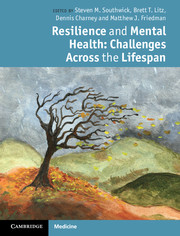Book contents
- Frontmatter
- Contents
- Contributors
- Preface
- Section 1 Pathways to resilience
- Neurobiology of resilience
- 2 Resilience in the face of stress: emotion regulation as a protective factor
- 3 Cognitive factors and resilience: how self-efficacy contributes to coping with adversities
- 4 Personality factors in resilience to traumatic stress
- 5 Social ties and resilience in chronic disease
- 6 Religious and spiritual factors in resilience
- Section 2 Resilience across the lifespan
- Section 3 Resilience in families, communities, and societies
- Section 4 Specific challenges
- Section 5 Training for resilience
- Index
- References
2 - Resilience in the face of stress: emotion regulation as a protective factor
from Section 1 - Pathways to resilience
Published online by Cambridge University Press: 07 September 2011
- Frontmatter
- Contents
- Contributors
- Preface
- Section 1 Pathways to resilience
- Neurobiology of resilience
- 2 Resilience in the face of stress: emotion regulation as a protective factor
- 3 Cognitive factors and resilience: how self-efficacy contributes to coping with adversities
- 4 Personality factors in resilience to traumatic stress
- 5 Social ties and resilience in chronic disease
- 6 Religious and spiritual factors in resilience
- Section 2 Resilience across the lifespan
- Section 3 Resilience in families, communities, and societies
- Section 4 Specific challenges
- Section 5 Training for resilience
- Index
- References
Summary
Introduction
Everyone experiences stress at one time or another – from major events such as the death of a loved one, to more minor stressors such as financial difficulties. Not surprisingly, exposure to stress is generally associated with a wide range of negative outcomes, including decreased well-being, increased incidence of disease, post-traumatic stress disorder, generalized anxiety disorder, and major depressive disorder (Dohrenwend & Dohrenwend, 1974; Kendler et al., 1999; Monat et al., 2007). However, not all individuals who are exposed to even high levels of stress develop such negative outcomes. In fact, recent evidence suggests that a considerable number of individuals exhibit resilience, which is commonly defined as maintained or improved mental health in the face of stress, after short disruptions (if any) to normal functioning (Freitas & Downey, 1998; Rutter, 1999; Luthar et al., 2000; Bonanno, 2005). Note that this definition, which we adapt here, conceptualizes resilience as a potential outcome after exposure to stress rather than a psychological trait that leads to positive outcomes (c.f. Norris et al., 2008).
It, therefore, appears that, in the face of comparable stressors, some individuals exhibit significantly impaired functioning while others show impressive resilience. Understanding the factors that govern the great individual variance in outcomes after stress is important for understanding mental health and for developing interventions and prevention programs that foster resilience. What factors, then, might predict resilience? One key to this question might lie in the fact that stressful events are inherently highly emotional (Sarason et al., 1978; Lazarus, 1999). For this reason, people’s ability to regulate emotions may be a critically important factor in determining resilience (Figure 2.1). The present chapter will review relevant literatures and suggest that there is indeed evidence to support this thesis. More specifically, we will propose that a specific type of emotion regulation, cognitive emotion regulation, holds particular promise for contributing to resilience.
- Type
- Chapter
- Information
- Resilience and Mental HealthChallenges Across the Lifespan, pp. 30 - 44Publisher: Cambridge University PressPrint publication year: 2011
References
- 203
- Cited by

